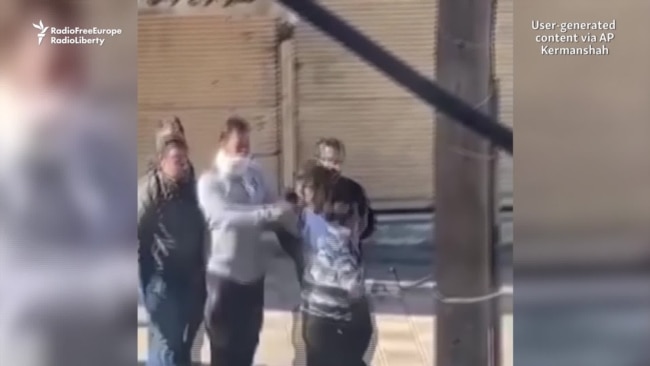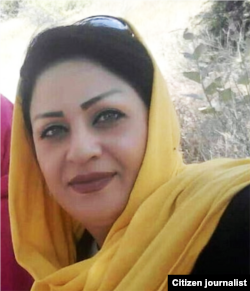Radiofarda – One year after Iran’s deadliest crackdown on anti-establishment protests, no one has been held responsible for the killing of hundreds of citizens.
Officials have instead pressured the families of some of those killed to remain silent and warned them not to hold public memorials for their loved ones.
Among them is the family of Ameneh Shahbazi, a 34-year-old mother of three who was shot dead as she was trying to help a wounded person during a November 17, 2019, protest in the city of Karaj, just west of Tehran.
Her brother, Mohammad Shahbazi, told RFE/RL’s Radio Farda that ahead of the anniversary of her death, marked earlier this week, the family had received threatening calls from “unknown numbers.”
“Only [the family] can come to the grave,” Shahbazi said the family was told by men they believed to be intelligence agents. “If there’s [even] one extra person, we will not allow it and we will take action.”
He said that at the funeral “it was only us and no one else.”
‘Why Was An Unarmed Woman Killed?’
The angry protests in some 100 cities and towns across the country last year were sparked by the November 15 announcement of an immediate increase in the price of gasoline amid a worsening economy under severe pressure from crippling U.S. sanctions.
The protests quickly turned political, with some chanting slogans against Iran’s leaders and calling for an end to the Islamic republic. Banks, gas stations, and police cars were set on fire.
At least 304 people were killed in four days of violence that followed the steep price hike, including many bystanders and 23 children under the age of 18, according to Amnesty International.
The London-based rights group has documented how security forces used lethal force, shooting many in the head or torso, indicating an intent to kill.
Iran’s Interior Ministry said that up to 225 people were killed. According to a lawmaker, six security agents were among those killed. Some 7,000 were reportedly detained.

EMBED SHARE
Footage Shows Crackdown On Iranian Protests
The government imposed a near-total Internet shutdown for almost a week to try to prevent the spread of the protests and make it difficult to obtain information about the crackdown. But a number of videos and images of the violence were posted online showing how security agents targeted people on the streets.
Shahbazi, who was on a shopping trip when she got caught up in a protest march, was among them. She died after being hit in the neck by a bullet, her relatives said.

Her funeral was held under a tight watch, with security agents in attendance. A year later, the family honored her amid renewed state threats.
“We don’t know what to do. Even when we talk a little [about the case], [the authorities] threaten that they will arrest us,” Shahbazi’s brother said.
“We don’t intend to [confront] anyone,” he said. “We’re just seeking information regarding my sister’s [case] and asking why [was a woman] killed who was not armed or anything.”
‘We Killed Him, So What?
Relatives of several other victims of the November crackdown in Isfahan and Behbahanalso told RFE/RL they had been warned recently to neither hold public memorials nor speak to the media about the deaths of their loved ones.
Sakineh Ahmadi, whose son, Ebrahim Ketabdar, was killed on November 16, 2019, as he was standing outside his shop in Karaj, says the family was prevented from holding a public memorial. “They didn’t allow us [to have a public ceremony],” she said. “We went to the grave but we were surrounded by agents. They said you can stay here only for 10 minutes.”
“They kept calling my son, my daughter, all of us, telling us that we shouldn’t have a ceremony. But I did go to my child’s grave. How could I not go?” she said.
“They harassed us a lot there. We got into a fight and they said very casually: ‘We killed him, so what? We did the right thing.’ It really pained me,” she added.
Ahmadi added that the authorities had threatened to detain her if she didn’t keep silent. “I said I don’t care [if I’m detained],” she said defiantly.
“I don’t want [blood money], I don’t want anything, I just want my son’s killer [to be brought to justice],” she recalled telling the intelligence officers.
Manuchehr Bakhtiari, the father of slain protester Pouya Bakhtiari, who was shot in the head, has been detained since July on unknown charges. Bakhtiari had criticized the clerical establishment following the death of his 27-year-old son, who had become a face of the demonstrations and the harsh crackdown that followed.
‘No Accountability’
The Iranian authorities have failed to hold an independent investigation into the bloody events, while the full extent of the violence remains unknown. Some rights groups have suggested the number of dead could be far higher than those that have been confirmed so far.
“One year after the November crackdown, Iranian authorities have avoided any measure of accountability and continue to harass the families of those killed during the protest,” Human Rights Watch researcher Tara Sepehrifar said in a statement released on November 17.
“Families of hundreds of victims, most of them from the more vulnerable segments of Iranian society, deserve to see those responsible for the serious rights violations held accountable,” she added.
Human Rights Watch, Amnesty International, the Center for Human Rights in Iran, and some 20 other rights organization have called for a UN-led inquiry into “the widespread and systematic crimes and serious human rights violations committed by the Iranian authorities during and in the aftermath of the November 2019 protests.”
- Golnaz EsfandiariGolnaz Esfandiari is a senior correspondent with Radio Free Europe/Radio Liberty. She can be reached at [email protected] FOLLOW SUBSCRIBE
- Fereshteh GhaziFereshteh Ghazi is a correspondent for RFE/RL’s Radio Farda.
 Shabtabnews In this dark night, I have lost my way – Arise from a corner, oh you the star of guidance.
Shabtabnews In this dark night, I have lost my way – Arise from a corner, oh you the star of guidance.


